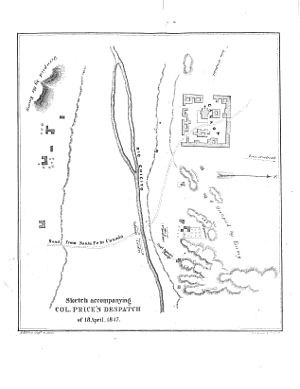Battle of Cañada facts for kids
Quick facts for kids Battle of Cañada |
|||||||
|---|---|---|---|---|---|---|---|
| Part of the Taos Revolt Mexican–American War |
|||||||
 A page from Colonel Price's report showing troop movements. |
|||||||
|
|||||||
| Belligerents | |||||||
| Commanders and leaders | |||||||
| Strength | |||||||
| 353 | 1,500 to 2,000 | ||||||
| Casualties and losses | |||||||
| 2 killed 7 or 6 wounded |
36 killed 45 captured or wounded |
||||||
The Battle of Cañada was an important fight during the Mexican–American War. It happened on January 24, 1847, in New Mexico. This battle was part of the Taos Revolt. It was a rebellion by Mexicans and Pueblo Indians against the American army that had taken control of New Mexico.
Contents
Why the Battle of Cañada Happened
Rebels Gather in New Mexico
During the Mexican–American War, the United States army took control of New Mexico. Many local people, including Mexicans and Pueblo Indians, were not happy about this. They wanted to take back their land.
Leaders like Chavez, Montoya, Lafoya, and Ortiz gathered a large group of these rebels. They met at a place called La Cañada. Their plan was to march to Santa Fe, which was held by the American army.
American Army Responds
Colonel Sterling Price was in charge of the U.S. forces in Santa Fe. On January 20, he found out about the rebels' plan. He had intercepted letters from them.
Colonel Price quickly put together his own army. He gathered 353 soldiers and local volunteers. On January 23, they marched north from Santa Fe. Their goal was to stop the rebels before they could reach the city.
Price's force included different groups of soldiers. There were mounted volunteers and infantry. They also had four small cannons called howitzers.
The Battle Begins
Meeting the Rebels
On January 24, Colonel Price's army met the large rebel force. The rebels were positioned on high ground near the road to Santa Cruz de la Cañada. They also held three strong houses at the bottom of the hill.
Colonel Price quickly set up his troops. He placed his cannons on the left side. They were ready to fire at the houses and the hill where the rebels were. His dismounted soldiers were protected by a nearby stream.
Fighting for Control
Price sent Captain St. Vrain to protect his supply wagons. These wagons were about a mile behind the main fighting. Once the wagons were safe, St. Vrain's group joined the battle.
Colonel Price ordered Captain Agney to attack the rebels in one of the houses. After that, his soldiers charged up the hill. They were supported by other officers, Lieutenant White and Captain St. Vrain.
Other groups of American soldiers also attacked. Captains McMillen's, Barber's, and Slack's men took control of the houses. These houses were protected by a strong fence.
American Victory
Colonel Price later reported that his troops quickly pushed back the rebels. He said, "In a few minutes my troops had dislodged the enemy at all points, and they were flying in every direction." This meant the American army had won the battle.
After the Battle
Rebel Leaders Captured
After the battle, the American army camped on the battlefield. The rebels retreated towards Taos.
Some of the rebel leaders faced consequences. Tafoya was killed during the fighting. Chavez was later killed at Taos Pueblo. Montoya was captured and faced punishment at Don Fernando, which is now the Town of Taos, New Mexico.
Next Steps in the Conflict
The Battle of Cañada was an important victory for the American forces. However, the conflict was not over. On January 29, Colonel Price met the rebels again. This next fight was called the Battle of Embudo Pass.
See also
 In Spanish: Batalla de la Cañada para niños
In Spanish: Batalla de la Cañada para niños

